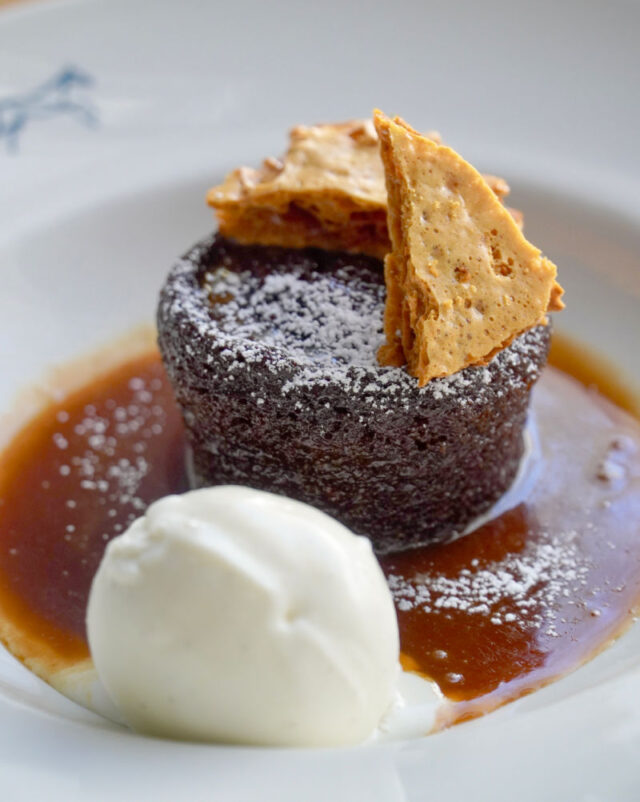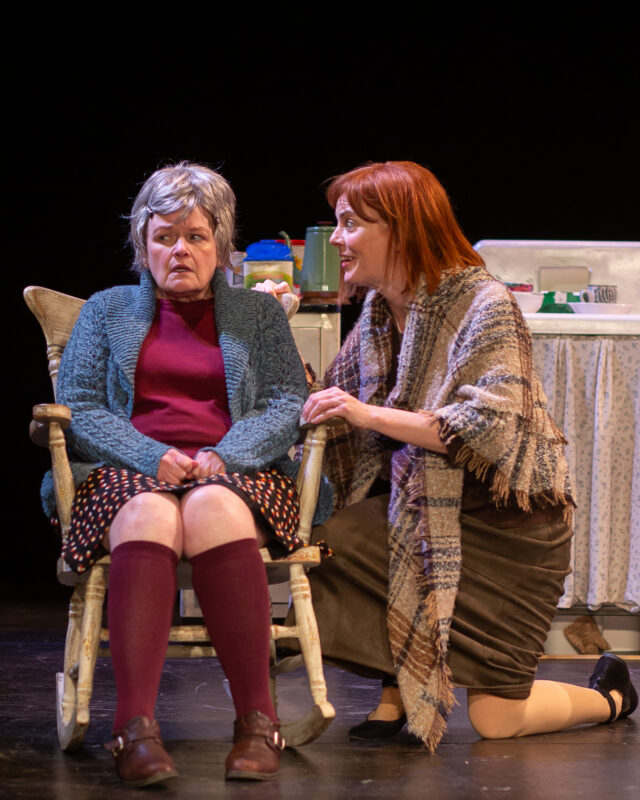Irish Philadelphia: You are choreographing a piece for BalletX. It’s a world premiere and what’s it called?
Marguerite Donlon: Yeah, that’s right. It’s a world premiere and it’s called “Big Wig.”
Irish Philadelphia: And where is that coming from?
Marguerite Donlon: Well, the inspiration came basically from my childhood of Irish dancing. Back in Ireland, that’s all we ever did. There was no other kind of dancing at that time. And I just remember as a child, first of all, thinking, “Gosh, we don’t use the arms? It’s so kind of stiff. It’s fun down the bottom, the legs.” And then I remember going to competitions and my mother, trying to curl our hair with kind of these rags, and my hair just always fell completely flat.
Anyway, as it turns out, years later when I had stopped Irish dancing, and you see it from time to time advertised, or you see it on online, then I noticed they had these huge wigs. And I thought, “How did they make their hair so curly?” But yeah, they were wigs. And I found these wigs somehow kind of funny and fascinating, and I also kind of thought, it seems like we’re looking more at the wigs than the footwork.
So anyway, it’s just one of those things you observe and you put it in the back of your head somewhere. Then Christine Cox, who’s the director and founder of BalletX, asked me to do a piece, and she’s like, “Why don’t you search in your mind back to your childhood? Maybe there’s something.” And then this image came up, this image of the Irish dancers with the wigs.
Yeah. So then I thought, “Maybe the wigs could be a starting point.” Starting with them a little bit funny, but then just using them completely different, just transforming from these wigs. So that’s a very long answer, sorry. But yeah, it touches on Irish dancing a little bit, but it’s mixed with contemporary movement, and it’s a journey. It’s a wacky journey.
Irish Philadelphia: Well, we certainly have our fair share of big wigs in the dance schools around Philadelphia.
Marguerite Donlon: Oh, yeah. I think you have great, amazing Irish dancers here. No?
Irish Philadelphia: We do. Yeah. Several very good schools. So, I’m curious to know, how long does it take to come up with a piece like this, how does it come together? I’m interested in how you think about it and where the ideas actually come from. And I know you’ve just talked about that a little bit, but how do you think about it?
Marguerite Donlon: Well, so before you actually start a piece, you do have to think about some ideas so you can share it with your team, especially because you have a costume designer, you may have a composer, you may have somebody for sets. So they all need information so that we can start working to create the picture, the bigger picture.
So, I usually start from the outer part of the sketch, and rough ideas, and then it gets kind of tighter and tighter and more detailed. The detail really comes when I get into the studio. So a lot of the first work is done away from the dancers, so not in the studio. And you put ideas down on paper, and so you settle on the costumes and roughly the music.
And then I come into the studio. And for me, that’s really important. That’s when it really starts happening because you have to, in my opinion, leave space for the dancers to kind of integrate into the piece. And each dancer has a wonderful personality, and each dancer has different movement capabilities and possibilities. So I really love tapping into their talents and their skills and their quirkiness, and that becomes really sort of the details of the piece.
So sometimes you feel like you’re swimming in the dark, but you just have to kind of follow where the flow is going. I think most creators know that, the whole feeling of following flow, and just allowing certain things just to happen. And then others, you guide other things, and then some things just happen and then you decide, “Yeah, that’s great. Let’s keep that, let’s go with that.” So it’s a very sort of fragile, delicate process.
Irish Philadelphia: So it’s not exactly starting out with a blank slate? There are some particular basic thoughts?
Marguerite Donlon: Yeah, initially it’s a blank slate, and then you put an idea down. And so the idea for this blank slate was literally wigs, a wig, really. My costume designer was like, “Ah, okay, a wig. Okay.” So then she started to have fun with the idea of what else can you do with a wig, apart from wearing it?
And we always say, when you’re brainstorming, there are no silly ideas. You bring out the child in you, the creative child, and you just let it run rampant, and then you pick the things out that make sense, and then you have to kind of bring it into a coherent piece.
And like I said, the wig was a starting point, but the wig sort of disappears at some point, because I suppose the term big wig is nobody wants to be the big wig, right? Or maybe they do. Yeah. So somehow, the wig becomes something else and slowly disappears and becomes more like it’s decorating the space. Yeah. I don’t know if you can imagine any of that or if that makes sense?
Irish Philadelphia: It does. Yeah. It sounds like there’s some gentle, good humor involved, too.
Marguerite Donlon: There’s a bit of humor in there, indeed. In that sense, I think it’s very typically Irish in a way. I think Ireland is a bit like the weather. You can go out with somebody and you can speak about all kinds of emotions in one evening. So it’s not just funny. Irish people do talk very deep and seriously, and inevitably there’ll be something about death, like, “Oh, you know your man?” “Yeah.” “Well, he’s dead.” And it’s like, “Oh. Oh.” And then you start talking about the family. And so I think there’s a fine line between humor and melancholy, let’s say, in Ireland, and they sort of go hand in hand. So yeah, the piece is funny and it’s also quite… There’s beautiful scenes, very touching and melancholic, maybe.
Irish Philadelphia: Yeah. I was interested to know whether there are particular ideas or emotions you were trying to put across or inspire in your audience?
Marguerite Donlon: Yeah, I think that’s why I call it a journey, because I think in the beginning you can’t help but smile with the girls and the wigs. And then of course, the guys get their hands on these wigs and they experiment and do something completely different with it.
So for a while, I think it’s a bit tongue in cheek, you’re smiling. But then it becomes more, let’s say, mysterious and moody. So it’s a real journey. And I think that’s what it’s like for me when I go home to Ireland, you just confronted with emotions. People are very open with their emotions, and they always come back to having a laugh. I think that’s the way to survive.
Irish Philadelphia: So, you started in Irish dance where in County Longford?
Marguerite Donlon: Where in County Longford?
Irish Philadelphia: Yeah.
Marguerite Donlon: In Longford. In Longford town.
Irish Philadelphia: Ah, okay. And how old were you when you started? I know that they start very young here.
Marguerite Donlon: Yeah. Yeah, I think I was pretty small. In fact, well, I don’t know, maybe I was five or something, five or six. They used to have, in those days, competitions, you have your jigs and your reels and stuff. But for the little ones, they had this makeup dance, a makeup dance, which is basically improvisation. And that was the one I loved. Oh, I loved it so much because we had one girl in the, Orlagh Byrne is her name, one of the senior dancers, and she was really good. And I used to love watching her and doing her twirls and her little feet stuff.
And so I would just improvise based on what I had seen. And I guess that was the beginning of my choreographic career. I even threw in a few arms, I think at some point. Yeah. But it just came a point that when I had to start learning the proper jigs and reels, I just felt, “Yeah, I got to use my arms.” And so yeah, I started making up dances then later with a bit of Irish footwork, but bringing in arms and body movements. And then I started to learn ballet, and I realized, “Oh wow, there are many dance forms that use the arms and upper body.”
Irish Philadelphia: Yeah, I was really interested in that. I’m told that you came to ballet relatively late, something like 13 years old?
Marguerite Donlon: Yeah, 14, actually.
Irish Philadelphia: 14. Yeah. So how did that happen? How were you inspired to make the switch? And were you exposed to ballet at that point, or how did that happen?
Marguerite Donlon: Oh, well, I stopped doing Irish dancing because it didn’t inspire me anymore, so that’s when I started doing my own thing. There was no ballet, otherwise I would’ve joined a ballet school or a contemporary. There was nothing in Longford. And then an Irish farmer, young, well-off Irish farmer was in South Africa on a kind of tour, and he met a wonderful South African lady, and they got married, and she came back and opened up a ballet school in Longford. And her name is Anica Dawson.
And yeah, I was her first student. And I remember calling her, she’d put an advertisement in the newspaper. And I called her and she said, “How old are you?” And I said, “14.” Maybe I was 13 going on 14. And she said, “Oh, you’re too old to start dancing.” And I was like, “Please, you don’t understand. I have to do this.” So she said, “Oh. Well, okay.” And then so she had a class for older girls like me, and then I was with her for two years. And I did exams from the Royal Academy of Dance, and it was clear this was my thing.
And then an English lady from obviously England, was over from the Royal Academy of Dance, and she saw me and she said, “Well, she’s very talented, but she’d need to go to a proper full-time school, like ballet dance school. And doing it once a week is never going to be enough.” So she took me, I lived with her, with this ballet teacher, her name was Dorothy Stevens, and her six cats.
Irish Philadelphia: That’s plenty.
Marguerite Donlon: It’s plenty. And I’m not a great cat lover. Yeah. So it was quite interesting. But she was brilliant. She gave me everything. I did my A-levels whilst I was there, and basically learned everything that was possible to learn within the dance situation. I did ballet, modern, jazz, tap.
So I did that for about three years. I went when I was 16, 16, 17, 18, 19. Yeah, 3 years in dance there, two and a half, which was crazy. Normally you would do it in longer. And then I was allowed to do class with the English National Ballet who were on tour. And to cut a very long story short, they basically took me into the company when they saw me, and then I was a ballet dancer.
Irish Philadelphia: Wow. You’re talking about two really entirely different styles of dance. Moving in Irish dance seems to be so tightly regimented, if that’s the right word?
Marguerite Donlon: Yes, that’s right. Yeah.
Irish Philadelphia: And then there’s, as you say, much more freedom of movement and expression in ballet. So, that must have been, for you, one of those, “Where have you been all my life?” moments.
Marguerite Donlon: Oh, yeah. It was just like, “Oh, this is amazing. I can really express myself and move.” And yeah, it was just beautiful. And then of course, that was ballet, and then I was introduced to contemporary dance. At English National Ballet, we worked with Christopher Bruce, but also Michael Clarke and Stephen Petronio. And later I worked with Billy Forsythe and Jiri Kylian. And so all of this contemporary work, even Bill T. Jones. The American viewers would know people like Bill, T. Jones and Melissa Clarke, I think.
But in any case, this was where I really excelled and I felt like this is my language. Because classical ballet is also very restricting. Classical ballet uses the arms, but there are certain positions, and you don’t really wander from those, your first, second, third, fourth, fifth. It’s very clean and it has a language that you don’t wander from. But contemporary dance, all of those rules and regulations are rubbed out. And so in a way, there are no rules, which is actually what I really like.
Irish Philadelphia: Just like jazz.
Marguerite Donlon: Yeah, exactly. Exactly. Yes. I went to a very nice jazz concert last night in Philly at Chris’ Jazz Club. Yeah, great jazz when you have players that can really improvise, it’s such a beautiful… Because improvisation is not just do whatever you want. You have to really be aware of what’s being played before and who you’re playing with. And it’s so complex, and so I think it’s just fantastic. I love it.
Irish Philadelphia: Well, it’s funny, you robbed me of my next question, which was to name-drop, and you’ve name-dropped a lot.
Marguerite Donlon: Yeah. Yeah.
Irish Philadelphia: So, how does what you learned from them inform what you do now?
Marguerite Donlon: I learned from what, sorry?
Irish Philadelphia: How does what you learned from them inform what you’re doing now yourself?
Marguerite Donlon: But from them being who’s them?
Irish Philadelphia: All those names you dropped.
Marguerite Donlon: Oh, all those names, oh really? Yeah. Well, in many ways, I think, not just in the style, but also in the way to work with people. For example, I really enjoyed working with Jiri Kylian because you felt seen as a person, and he really took into consideration you and your abilities. I loved working with choreographers who, it wasn’t just about technique, and it’s about the people, because as a choreographer, your task is to bring the best out of people. You want them to also step out of their comfort zone without too much fear.
So, all of those choreographers, the good ones, had that ability, and you felt always pushed, but not in a terrible way. So I learned a lot. I think I learned from everybody I worked with, even if it was in the hard way, or sometimes you would learn by saying, “Well, that’s exactly how I don’t want to do things.” Being suppressed as a young artist, it’s no way to… You cannot progress if somebody’s suppressing you or you’re working under fear. You want to make your artists feel great and valued.
Irish Philadelphia: So you’re an influencer yourself now?
Marguerite Donlon: Yeah. Yes.
Irish Philadelphia: How do you think your work is influencing the world of dance?
Marguerite Donlon: That’s an interesting question. I’m probably not the one to ask, but I don’t know. I do know that I’m not afraid to allow humor to enter into the situation. I don’t force humor, but just life is sometimes very funny. And it can be in a very ironic way. So I am known to sort of play with humor often. I guess I’m also known to, people will say, “You see the personalities of the dancers very much on stage,” and that’s very nice. It’s very touching. You feel that there are people on stage and not just these amazing bodies doing steps.
Oh, and I think that’s also in the piece. In the beginning of the piece, if everybody wears the same wig, everybody then looks the same, don’t they? And they’re doing the same very regimented ballet steps. There’s no personality. And I think this piece is also about striving for recognition as individuals. So the wigs inevitably, of course, do come off, and are used in different ways because we want to applaud and support creativity. And sometimes you’re dealt a bad hand, and then it’s up to you to go, “Okay, how can I switch this around to a positive? How can I make something out of this?” Yeah, so I think those kind of elements come into it. Yeah.
Irish Philadelphia: Well, I’m very grateful for your time. I really appreciate it.
Marguerite Donlon: No, I’m grateful for your interest.Irish Philadelphia: Oh, yeah. Happy to help.
The piece is running from November 13th-17th at the Suzanne Roberts Theatre. Here is the link to purchase.




